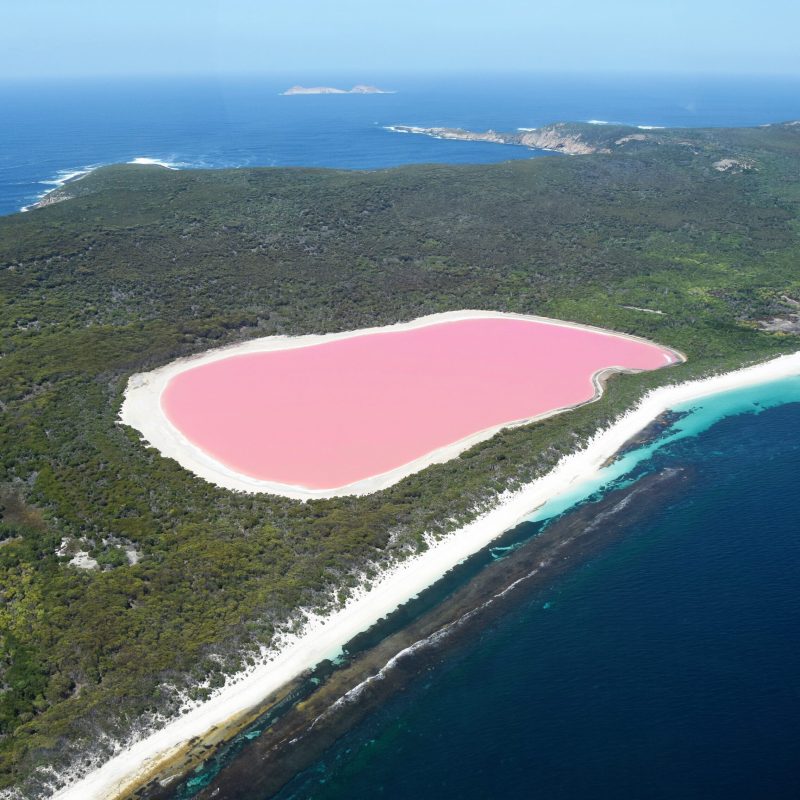
Strawberry milkshakes, Pepto-Bismol, cotton candy, pink lemonade in summertime, bubble gum — whatever this lake reminds you of, it’s probably a bright shade of pink.
Videos by TravelAwaits
Lake Hillier is Australia’s lovely pink lake that tourists marvel at from up above.
We have answers to all the Lake Hillier questions you might be asking upon seeing striking photos of the natural wonder, so read on!

Where Is Lake Hillier?
The lake is located on Middle Island, which is the largest island in the Recherche Archipelago off the coast of Western Australia. Lake Hillier is bordered by a thick forest of eucalyptus and paperback trees, with the Pacific Ocean right nearby.
Lake Hillier is small — less than half a mile long and not even a quarter of a mile wide. But what it lacks in size it makes up for in delicate beauty.

What Is The History Of The Lake?
The first recorded discovery of the lake was in 1802 by British navigator and cartographer Mathew Flinders. He named the pink lake after William Hillier, a deceased crew member who died of dysentery shortly before.
After inspecting the lake up close, the crew realized it was chock-full of salt. Flinders and his crew were the first of many to use the lake for its salt deposits. In the early 20th century, salt was mined for the lake, but the lake is now uninhabited and only visited for tourism purposes.

Why Is It Pink?
There’s been a lot of controversy about why the lake is actually pink, but thanks to National Geographic, we finally have some answers.
Basically, we can thank salt.
The lake contains two salt-loving microorganisms — Dunaliella salina and halobacteria. Dunaliella salina microalgae produce carotenoids, photosynthetic compounds that have a unique pinkish hue visible to the naked eye. In addition, halobacteria “thrives in salty environments like Lake Hillier, is naturally pink, and more than capable of dying large bodies of water pink.”
Both microorganisms are believed to combine to create Lake Hillier’s pink water. From up above, the water is an intense bubblegum color, but up close, the water is actually a faint pink.

Lake Bumbunga / A Life Beneath Stars / Shutterstock
Are There Other Pink Lakes In The World?
Lake Hillier has some competition — similar cotton candy-hued lakes are more common than you might’ve guessed.
Lake Retba, situated near Senegal, has a similar pink hue during the dry season between November and June. Unlike Lake Hillier, the lake fluctuates in color — sometimes the water is a baby pink, and other times the water transforms into a rusty, almost murderous shade of red.
Believe it or not, Lake Hillier isn’t even the only pink lake in Australia. Lake Hart, Lake Bumbunga, and Hutt Lagoon all give Lake Hillier a run for its money. Lake Hillier might not be the only pink lake in the world, but it is the only pink lake with water that still looks pink even when it’s poured in a glass. That makes it the coolest one, right?

Can You Visit?
Lake Hillier’s water is perfectly safe to swim in, and because of its saltiness, you would likely float on its surface like an apple. The only problem — no one can.
Tourists can’t access the lake from the ground. The only way to view the bubblegum lake for yourself is by flight. Tours of the lake depart from Esperance, a city on the southern coast of Western Australia, and last for an hour and a half. The tickets might be pricey (they run $385 AUD per person), but the trip will give you views of the lake and Middle Island you won’t soon forget.
The world is a strange place and some of its bodies of water are even stranger. Lake Hillier is certainly not alone in its uniqueness. Meet the world’s most peculiar lakes — with colorations ranging from lime green to a lake that changes colors like a mood ring.
